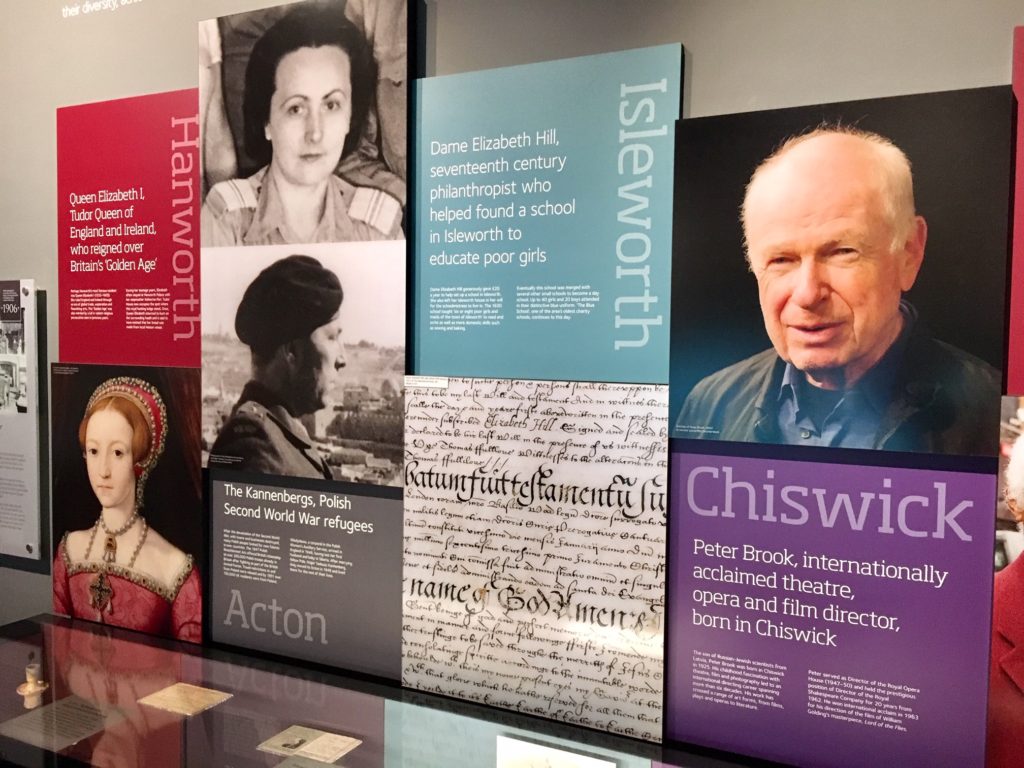Beyond W4
The Chiswick Timeline of Writers and Books is a record of writers who have lived in Chiswick W4 and written a book, or have written books about the area. Chiswick is situated in two London boroughs – Hounslow and Ealing. See map of W4 postcode.
Many writers have lived in neighbouring areas and, though these are not included, we work closely with organisations that keep relevant records such as Arts & Crafts Hammersmith (see Hammersmith Terrace below), Brentford and Chiswick Local History Society, and Gunnersbury Park & Museum (the local museum for Ealing and Hounslow, display above).
We know of several borderline roads worthy of mention – notably Hammersmith Terrace, Stamford Brook Road and St Peter’s Square below. If you have suggestions – or would like to help develop records for these neighbouring areas – please email admin@chiswickbookfestival.net.
Ealing W5
We now have a Timeline of Ealing Writers & Books. To avoid double-counting, it excludes authors in the Chiswick W4 area of the Borough of Ealing – but in due course we will give more details of the overlap authors. See also records at Gunnersbury Park & Museum (image above)
The A-Z of Ealing Rock contains references to several books about rock music in the area.
Hammersmith Terrace W6
Hammersmith Terrace is in W6 but in some records (including that of English Heritage below) is described as ‘Chiswick’, because it is a continuation of Chiswick Mall. It was home to several distinguished writers.
English Heritage: Plaque to Sir Emery Walker
Chiswick – A Family Habitat in the Twentieth Century – Hammersmith Terrace from the South Bank of the Thames.
See information about ‘who was who in Hammersmith Terrace’ on this website:
Panorama of the Thames
There have been several illustrious occupants of the houses in this terrace.
– At No. 1 the Doves Press was first established before moving downstream a short way to Doves Passage. Sir Emery Walker, who established the press, first lived at No. 3, subsequently leased to Edward Johnston (1872-1944), calligrapher and typographer, who taught some eminent students like Eric Gill and Cobden Sanderson at the Royal College of Art.
– No. 5 – a leading C19th wood engraver, W.H. Hooper, lived here.
– No. 7 was occupied by Emery Walker when he moved there, and this property has been retained in the style and character of the time thanks to its inheritance by his daughter Dorothy who conserved the original arts and crafts interior with many treasured details. It is from time to time open to the public through the Emery Walker Trust and to visit the house is to step back in time.
– No. 8 was occupied by May Morris (1862-1938), daughter of William Morris and good friend of Dorothy Walker, next door at no. 7 at the time. May was an influential designer and director of the embroidery department at Morris and Co. There are beautiful examples of her best work at Kelmscott House. Famous playwright George Bernard Shaw, who was close to May, stayed at this house for many months, to the detriment of May’s marriage.
– No. 10 was occupied by F.G. Stephens (1828-1907), a member of the Pre-Raphaelite Brotherhood and art critic who promoted the aims of the brotherhood to the public. This property was more recently the home of set and costume designer Maria Bjornson (1949-2002) who designed for acclaimed productions such as the Phantom of the Opera and Sleeping Beauty.
– No. 12 was occupied by Sir Alan Patrick Herbert, prolific author and MP (1890-1971). And his son John has lived at no. 12 all his life. The family loved the river and sailed it, with a close association with London Corinthians a short way downstream.
– No. 14 was home of Sir Clifford Wintringham (1710-1794) in the late C18th, physican to George III and Physician General to the army.
– No. 16 was lived in by the Irish actor and playwright Arthur Murphy (1727-1805), lead in Richard III and Othello at Drury Lane, and a political writer. More recently Victor Pasmore (1808-1988), post-war artist, lived here and painted many river views.
Stamford Brook W6
Stamford Brook lies on the edge of Bedford Park W4 but is in London W6. The Chiswick Timeline would not be complete without reference to it, not least because several paintings by the great French Impressionist Camille Pissarro which are labelled ‘Bedford Park’ actually feature scenes in Stamford Brook. Shirley Seaton’s article for the Brentford & Chiswick Local History Journal, Camille Pissarro: Paintings of Stamford Brook, 1897, explains all:
In April 1897, Camille’s son Lucien moved with his English wife to 62 Bath Road, Bedford Park, where Camille enjoyed painting from the balconied flat roof at the back of the house. In 1902, they moved to the little Georgian cottage, The Brook, on Stamford Brook Road, which remained their home for the rest of their lives. The actor Sir Alec Guinness lived in this house in the winter of 1945-6 (and wrote several books).
Pissarro’s paintings are reproduced in Stamford Brook, An Affectionate Portrait by Reginald Coleman & Shirley Seaton, Stamford Brook Publications, revised edition 1997.
Read also:
Local Paintings by Lucien and Ludovic-Rodo Pissarro by Shirley Seaton – Brentford & Chiswick Local History Journal.
Intimate Insight – Mark Glazebrook, The Spectator
See more records at Brentford and Chiswick Local History Society
St Peter’s Square W6
Several distinguished writers have lived in St Peter’s Square, just over the W4 border in W6. Details to follow. See more at St Peter’s Residents Association and in ‘St Peter’s Estate: A History of St Peter’s Square and its Neighbourhood’ by Jilly Paver.
Brentford TW8
See records at Brentford and Chiswick Local History Society

